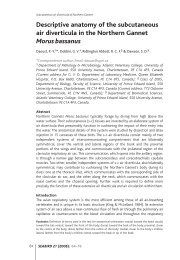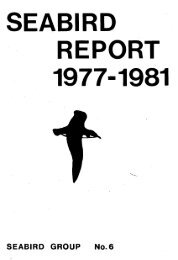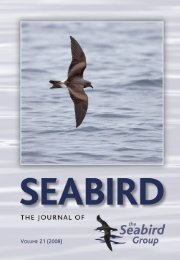You also want an ePaper? Increase the reach of your titles
YUMPU automatically turns print PDFs into web optimized ePapers that Google loves.
2001 <strong>Seabird</strong>s on Ascension 193<br />
system (Fig. 1), apparently first described by Dampier (1703, quoted above)<br />
may provide food for seabirds here. Basically the easterly trade-winds drift<br />
surface water to the west in the tropical oceans, and compensatory countercurrents<br />
then return east, often below the westward surface drift. <strong>The</strong> change in<br />
the direction of Coriolis' force also leads to a divergence in westbound currents<br />
near the equator, causing local turbulence and upwelling. This leads to increased<br />
biological productivity, attractive to tuna which drive their prey to the sea<br />
surface where it becomes available to birds (Khanaychenko 1965; Neumann<br />
1965; Longhurst & Pauly 1987; Scullion 1990 in Ashmole et al. 1994).<br />
<strong>The</strong> RNBW S have reported flocks of seabirds occur here (annual<br />
reports in Sea Swallow), but there have been few detailed accounts, possibly<br />
because most activity occurs over a narrow, fluctuating belt which is liable to be<br />
crossed in a few minutes, half the time by night, when the birds can only be<br />
heard calling in the darkness. Where counts were made, the vicinity of the<br />
equator was frequented by over a hundred times more birds than a comparable<br />
area to the south (Table 2), and Jesperson (1930) reported equally few birds to<br />
the north.<br />
In general, Ascension seabirds go out to sea in the morning, and few<br />
can be seen feeding from the shore except when there is an influx of pelagic<br />
prey fish. Flocks of hundreds of Ascension Frigatebirds Fregata aquila, Masked<br />
and Brown Boobies Sula dactylatra and S. leucogaster, Sooty Terns, noddies<br />
Anous sp. and White Terns Gygis alba feed in declining numbers for at least a<br />
hundred miles out to sea during the day. When a flock formed the first birds to<br />
appear were adult Ascension Frigates which came down out of the sky, after<br />
which Sooty Terns, Black <strong>No</strong>ddies Anous minutus and Masked Boobies, with a<br />
few Brown Boobies and small skuas Stercorarius sp. joined them over the sea.<br />
Although the skuas often chased the other birds, the Ascension Frigates did not<br />
hover over the rest and parasitise them as Magnificent Frigatebirds Fregata<br />
magnificens do around the West Indies, but led the feeding frenzy, though they<br />
rob other birds at other times.<br />
<strong>The</strong>se fish shoals might be feeding in eddies passing along the South<br />
Equatorial Current as already mentioned. Alternatively, when naval exercises<br />
were carried out west of Ascension on 11 Feb 1985 most birds were seen where<br />
the sea surface temperature fell from the usual 27.8° to 26.8°C eight miles<br />
offshore, implying turbulence and upwelling to the lee of the island. A thousand<br />
Black <strong>No</strong>ddies with fewer Brown <strong>No</strong>ddies Anous stolidus, Brown Boobies and<br />
an immature Red-footed Booby occurred here again on l6 April 1986, when<br />
although some breeding Sooty Terns dispersed in all directions, most went NW.<br />
In 1976-1977, 1993 and 1996-1997 Simmons and Robin Prytherch also saw<br />
many birds, mainly boobies and Black <strong>No</strong>ddies, return from the NW along the<br />
north coast of Ascension in the evening to roost in the vicinity of Boatswainbird








